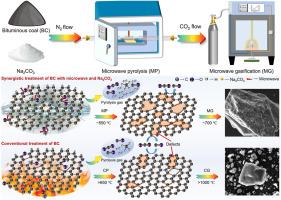微波与熔融Na2CO3对烟煤热解气化的协同效应
IF 6.2
2区 工程技术
Q2 ENERGY & FUELS
引用次数: 0
摘要
研究了微波和碳酸钠(Na2CO3)对烟煤热解气化特性的影响。在~ 550℃的温度下,利用微波对煤中的有机化合物,尤其是极性化合物进行有效热解,产生CO和H2,总绝对收率超过80%。相比之下,Na2CO3需要650℃以上的温度才能与煤中的有机物发生反应,其CO和H2产率不超过微波热解(MP)的1/3。从常规热解(CP)中收集的BC炭的微波气化和常规气化(MG和CG)的活化温度分别为~ 850℃和~ 950℃。通过微波与Na2CO3结合,大幅度降低至650-700℃。微波与Na2CO3的协同作用促进了碳骨架内结构紊乱的发展和碳空位的形成,从而实现了炭的快速低温气化。本文章由计算机程序翻译,如有差异,请以英文原文为准。

Synergistic effects of microwave and molten Na2CO3 on pyrolysis and gasification of bituminous coal
In this study, the effects of microwave and sodium carbonate (Na2CO3) on the pyrolysis and gasification characteristics of bituminous coal (BC) were evaluated. Applying microwave enabled effective pyrolysis of organic compounds, especially polar ones, in the coal at ∼550 °C, producing CO and H2 with a total absolute yield exceeding 80 %. In contrast, Na2CO3 required temperatures above 650 °C to react with organics in the coal, producing no more than 1/3 of the CO and H2 yield achieved via microwave pyrolysis (MP). The activation temperatures of BC chars, collected from conventional pyrolysis (CP), for microwave and conventional gasification (MG and CG, respectively) were ∼850 °C and ∼950 °C, respectively. By combining microwave with Na2CO3, substantially reduced to 650–700 °C. The synergistic effects of microwave and Na2CO3 promoted the development of structural disorder within the carbon framework and formation of carbon vacancies, thereby realizing rapid low-temperature gasification of the char.
求助全文
通过发布文献求助,成功后即可免费获取论文全文。
去求助
来源期刊

Journal of The Energy Institute
工程技术-能源与燃料
CiteScore
10.60
自引率
5.30%
发文量
166
审稿时长
16 days
期刊介绍:
The Journal of the Energy Institute provides peer reviewed coverage of original high quality research on energy, engineering and technology.The coverage is broad and the main areas of interest include:
Combustion engineering and associated technologies; process heating; power generation; engines and propulsion; emissions and environmental pollution control; clean coal technologies; carbon abatement technologies
Emissions and environmental pollution control; safety and hazards;
Clean coal technologies; carbon abatement technologies, including carbon capture and storage, CCS;
Petroleum engineering and fuel quality, including storage and transport
Alternative energy sources; biomass utilisation and biomass conversion technologies; energy from waste, incineration and recycling
Energy conversion, energy recovery and energy efficiency; space heating, fuel cells, heat pumps and cooling systems
Energy storage
The journal''s coverage reflects changes in energy technology that result from the transition to more efficient energy production and end use together with reduced carbon emission.
 求助内容:
求助内容: 应助结果提醒方式:
应助结果提醒方式:


